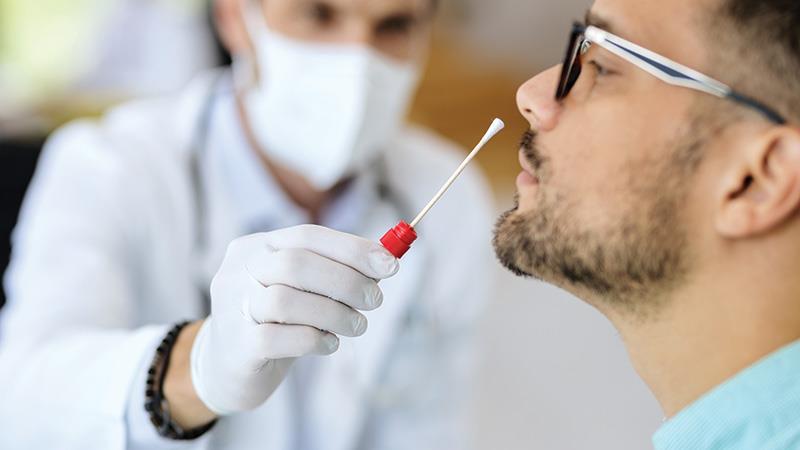
The Malaysian Society of Infection Control and Infectious Diseases (MyICID) in collaboration with Family Medicine Association Malaysia (FMSA) and Malaysian Medical Association (MMA) have launched an educational campaign themed ‘COVID-19: Quickly test and treat.’ This campaign is to urge the public, especially high-risk groups such as patients with chronic diseases, to undergo the COVID-19 vaccination and booster dose; use the COVID-19 self-test kit to test if they have symptoms; and seek treatment within 5 days after the onset of symptoms.
In an interview with MIMS Doctor, Dr Suriani Sulaiman, a family medicine specialist at Klinik Kesihatan Kg Pandan, and Dr Suraya Hanim Abdullah Hashim, an infectious disease physician at Hospital Ampang, answered commonly asked questions about COVID-19:
Q: What are the early symptoms of COVID-19 to look out for?
Dr Suriani (SS): Early symptoms of COVID-19 might be like other viral infections such as runny nose, sore throat, cough, fever, loss of sense of taste and/or smell, headache, and body ache.
Q: Which test kits are better: saliva-based or nasal-based?
SS: According to a data review that was published in JAMA Internal Medicine, the numbers between the two were comparable. Nasopharyngeal swab tests showed a sensitivity of 84.8 percent (95 percent credible interval [CrI], 76.8 percent–92.4 percent) and a specificity of 98.9 percent (95 percent CrI, 97.4 percent–99.8 percent) in detecting positive COVID-19 infections. Saliva-based tests had a pooled sensitivity of 83.2 percent (95 percent CrI, 74.7 percent–91.4 percent) and a pooled specificity of 99.2 percent (95 percent CrI, 98.2 percent–99.8 percent). The data review was a compilation of 16 studies that involved 5922 participants. [JAMA Intern Med 2021;181(3):353–360]
Q: When do patients need to see their doctor for treatment? Do they go to government or private clinic?
SS: A saliva self-test kit is adequate to diagnose COVID-19 infection when the patient starts to have symptoms, which suggest COVID-19 infection. When they test positive for COVID-19, they are required to self-quarantine themselves to prevent the spread of infection to others especially the high-risk group. However, if they do not have the capacity to do the self-test, they should be encouraged to go to any government or private healthcare facilities for testing.
For category 1 infection, patients normally have no symptom, and they may not need to seek treatment. Whereas category 2–3 patients should be encouraged to seek treatment as they might be eligible for anti-viral medication. Patients with comorbidities, aged above 60, weak immune system, obese, current / ex-smoker and not vaccinated should be strongly encouraged to seek treatment as early as possible for further assessment.
COVID-19 patients in category 2–3 especially the high-risk group are treated with nirmatrelvir/ritonaviris (PaxlovidTM) to reduce the illness severity. However, it must be started within 5 days from the onset of symptoms. This medication is available in government COVID-19 Assessment Centre (CAC) as well as in some private clinics. The list of clinics where the medication is available can be looked up at: https://covid-19.moh.gov.my/makluman/senarai-fasiliti-kesihatan-swasta-bagi-rawatan-covid-19-dengan-paxlovid and https://covid-19.moh.gov.my/hotline
Q: When should patients be referred to the hospital?
SS & Dr Suraya Hanim (SH): Those who should be referred to the hospital for admission are:
· Adult Patients who have pneumonia (category 3–5), are unstable, those with uncontrolled comorbidities and immunocompromised hosts.
· For paediatrics patients, those who are less than 1 year old with pneumonia (category 3 and above) or paediatric patients with significant comorbidities (at category 2 and above).
· Pregnant mothers with certain specific conditions.
Q: What is the recommended treatment for COVID-19?
SH: Oral antiviral such as nirmatrelvir/ritonavir or intravenous remdesivir if it is available in the hospital are the recommended treatments for patients that fit certain indications and have experienced less than 5 days of illness. For more severe patients who require further treatment during the cytokine release syndrome (CRS) phase, steroids or other immunomodulators such as baricitinib or tocilizumab are recommended.
Q: How many days should patients remain in isolation?
SH: Patients are supposed to be quarantined for 7 days. However, if they test negative on day 4, they can be released earlier than 7 days. There is no need for further testing. They should follow the instructions in their MySejahtera app. In the hospitals, the patients are managed according to the severity of illness as well as the immunocompromised state.
Q: At which point should patients test for COVID-19?
SH: They are encouraged to test for COVID-19 as soon as they have symptoms and to seek early treatment. Therefore, treatment can be started within 5 days of symptoms onset. This is especially important for those in the high-risk groups such as those with comorbidities because they may progress into severe COVID-19.
Q: What are the symptoms of long COVID?
SH: Long COVID is a continuation or development of new symptoms 3 months after the initial SARS-CoV-2 infection, with symptoms lasting for at least 2 months and no other explanation. Studies show that around 10–20 percent of patients go on to develop long COVID. Common symptoms of long COVID are fatigue, shortness of breath and cognitive dysfunction. Unfortunately, long COVID can affect any system in the body, and this can put a toll on patient’s daily lives. The WHO has reported nearly 200 different symptoms of long COVID. [Available at: https://www.who.int/europe/news-room/fact-sheets/item/post-covid-19-condition. Accessed on 1 March 2023]
Q: What is the recommended treatment for long COVID?
SH: There is no specific treatment for long COVID. It requires a multidisciplinary approach as the symptoms can be varied. It must be patient-focused with the aim of alleviating symptoms that patients may be experiencing. Rehabilitative interventions and self-management techniques are some of the treatments for patients with long COVID.
Q: What is the cure rate for long COVID? How long do patients have the symptoms of long COVID?